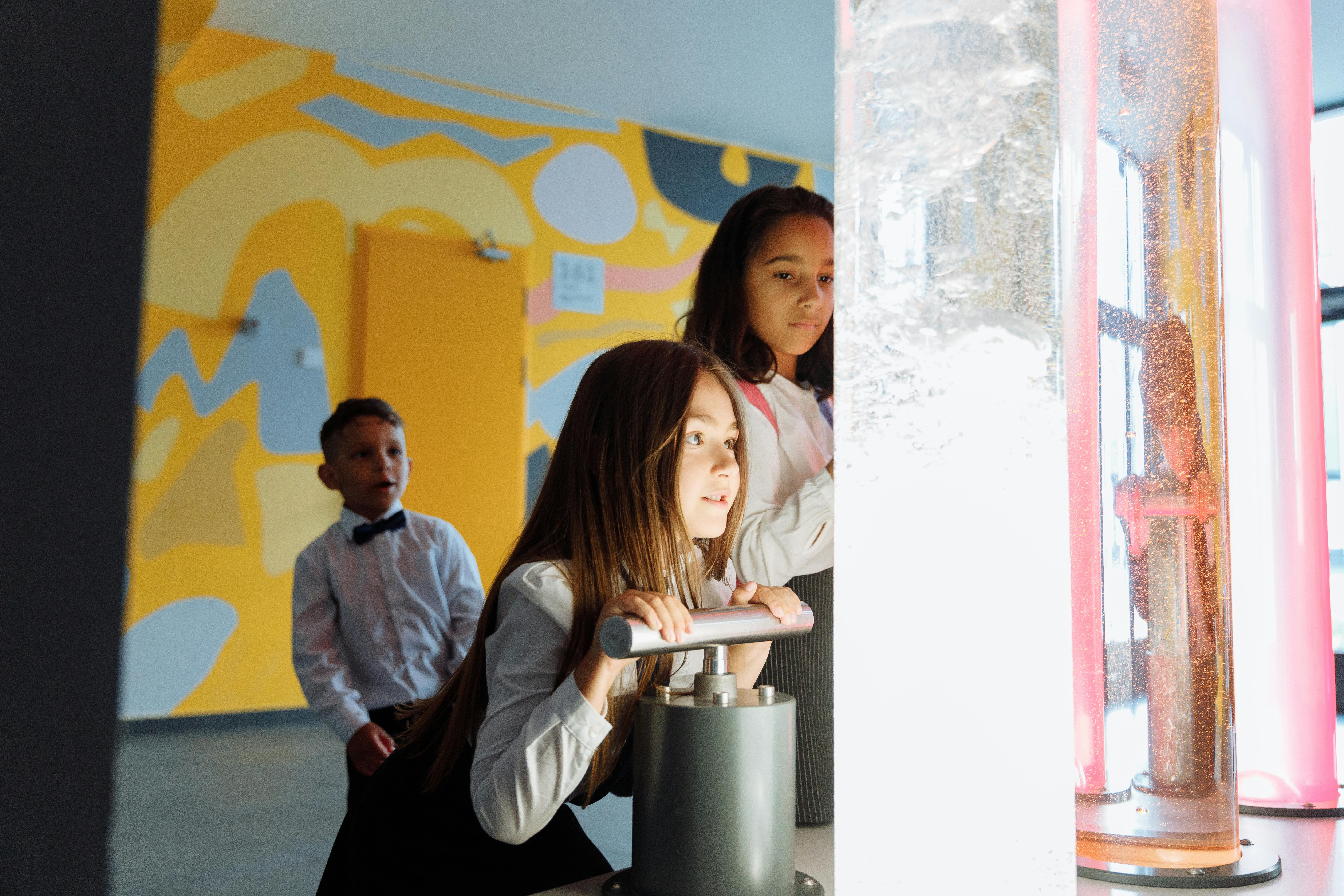As an affiliate, I earn from qualifying purchases, but this doesn't affect the reviews or recommendations—your trust is important to me!
Creating Your Own DIY Lava Lamp Science Experiment

Today, We're Making:
- - DIY Lava Lamp Science Experiment
- - 'Travel to Mars': On this date, kids can build a model of a Mars Rover to explore the science behind space exploration. Using basic materials like cardboard, glue, and a small motor, kids can learn about engineering and robotics.
- - 'Solar Power Magic': Given the date in mid-June.
DIY Lava Lamp Science Experiment
Remember those mesmerizing, retro lava lamps that used to light up your room as a kid? Now, imagine the delight and surprise on your child's face when they discover they can make one themselves. Welcome to our DIY Lava Lamp Science Experiment, an incredibly fun and illuminating DIY project that brings the magical beauty of science right into your home.
This easy, hands-on science activity not only breathes life into learning, but also doubles up as a funky, homemade lava lamp. Are you ready to brighten your home laboratory and create a splash of swirling, dancing, dazzling colors? Let's dive in.
How to Build Your DIY Lava Lamp Science Experiment
First things first, gather all the items you'll need for this vibrant DIY project. You will require the following:
- A transparent container, preferably a tall glass jar or bottle
- Vegetable oil or baby oil (about three-fourths of the jar's capacity)
- Water (fill the remaining one-fourth of the jar)
- Food coloring of your choice
- Effervescent tablets (like Alka-Seltzer)
Now that you've secured everything for your homemade lava lamp, let's start creating some magic. This easy science experiment is all about density and chemical reactions, making it exciting for curious young minds and grown-ups alike!
Witness the Colorful Mingle Right in Your Home Laboratory
Begin your DIY lava lamp science experiment by filling the jar three-fourths full with oil. Now, top this off with water until it's nearly full, but leave a little space at the top. You'll notice that the water settles at the bottom, while the oil remains above. This creates an enchanting layering effect — the first evidence of our exploration into density!
Next, ask your child to pick their favorite color for their DIY lava lamp. Add about 10 drops of the chosen food coloring into the jar. Make sure to use enough coloring, as the water needs to be fairly vibrant to see the lamp effect clearly.
Watch as your homemade lava lamp begins to come alive with color. Here, you might want to take a moment to talk about how food coloring mixes with water but not with oil, illustrating the concept of hydrophilic and hydrophobic substances. It's another fascinating facet of this awesome hands-on science experiment!
The Exciting Final Stage of Your DIY Science for Kids
The fun really begins in the final stage of this DIY lava lamp science experiment. Break the effervescent tablet into a few pieces and drop them into the jar. Remember to step back and observe the captivating spectacle that unfolds. As the tablet pieces sink and start to dissolve, they react with the water to create gas bubbles. These bubbles rise through the oil creating an eruption of dancing, glowing blobs that mimic the mesmerizing motions of a real lava lamp.
This lively DIY project not only familiarizes kids with basic scientific principles but also offers a creative and enjoyable science fun at home. They're learning about density, solubility, and chemical reactions, all while making a lava lamp!

The Magical Conclusion of Our Exhilarating Science Journey
So there you have it! Our exhilarating journey into the realm of science and creativity comes to a magical conclusion. This DIY Lava Lamp Science Experiment not only educates young, inquisitive minds about density, solubility, and reactions, but also promises a spectacle of vibrance and delight - right in your own home.
You've successfully turned fun into a teacher, and science into a thrilling, hands-on adventure. Your very own homemade lava lamp now decorates your home laboratory, symbolizing a triumph of curiosity and learning. Just like those wondrous dancing blobs in your lava lamp, may the spark of fascination and exploration continue to rise within you and your child.
Until our next enchanting journey into the world of DIY science experiments - keep creating, keep learning, and keep having fun!

You May Also Like These:
Travel to Mars: STEM Project
Materials Needed:
- 1 large cardboard box (rocket)
- Various colors of paint
- Construction paper
- Scissors
- Glue
- Markers or crayons
- Astronaut costume (optional)
Instructions:
Step 1: Design the Rocket
Begin by painting the outside of your cardboard box. Allow your child to be creative with this step. Once the paint is dry, you can add windows, a door, and any other details with the construction paper.
Step 2: Build the Interior
Now, focus on the inside of the box. You can create seat belts using old belts or strips of fabric. If you have any spare buttons or knobs, these can be added to create a control panel.
Step 3: Become an Astronaut
Once the rocket is built, let your child dress up as an astronaut if you have a costume available. If not, simply wearing white clothes can give the same effect.
Step 4: Blast Off!
Now that your rocket is prepared and you have an astronaut, it’s time to blast off! Encourage your child's imagination by counting down and simulating a launch sequence. Have them practice their astronaut duties in the rocket ship and enjoy the journey to Mars!
Note: While this project does not literally transport your child to Mars, it encourages creativity, develops fine motor skills, and can lead to an interest in space exploration!
DIY Non-Toxic Homemade Glue
Ingredients:
- 1 cup Flour
- 1/3 cup Sugar
- 1.5 cups Water
- 1 tsp Vinegar
Instructions:
Step 1: Mix Dry Ingredients
In a medium-sized bowl, combine the flour and sugar. Stir until mixed thoroughly.
Step 2: Add Water
Gradually add 1 cup of water to the dry mixture while stirring continuously.
Step 3: Cook the Mixture
Transfer the mixture into a pan and heat over medium heat. Gradually add the remaining 1/2 cup of water while stirring continuously. When the mixture comes to a slow boil, reduce the heat and continue stirring until it thickens.
Step 4: Add Vinegar
After the mixture has thickened, remove it from the heat and add vinegar. Allow it to cool before use.
Step 5: Store the Glue
Once the glue has cooled down, it can be stored in an airtight container in the refrigerator for future use. Remember to stir before use.
DIY STEM Project: How to Make Homemade Glue
Ingredients:
- 1 cup of Flour
- 1/3 cup of Sugar
- 1 1/2 cups of Water
- 1 tsp. Vinegar
Instructions:
- Gather All Ingredients: Make sure you have the necessary ingredients (flour, sugar, water and vinegar) available.
- Combine Dry Ingredients: In a pot, combine 1 cup of flour with 1/3 cup of sugar.
- Add Water: Mix in 1 1/2 cups of water, ensuring that the mixture is smooth and there are no lumps.
- Heat the Mixture: Put the pot on the stove over medium heat. Stir the mixture continuously until it starts to thicken.
- Add Vinegar: Once the mixture has thickened into a paste, remove it from heat and stir in the teaspoon of vinegar.
- Let it Cool: Let the homemade glue cool before transferring it to a storage container. Your homemade glue is now ready to use for STEM projects!
STEM Project: Building a Small Motor
This project is designed to engage children in the exciting world of engineering and helps them understand the basics of how motors work.
Materials Needed:- 1 AA battery
- 2 small magnets
- Insulated thin copper wire
- 2 safety pins
- Piece of foam board (30cm x 30cm)
- Bendable metal wire (like from a coat hanger)
- Tape (electrical tape works best)
- Prepare the Work Space: Clear a flat, clean space to work. Gather all the necessary materials.
- Set up the Battery and Magnets: Place the AA battery on the foam board. Place one magnet at each end of the battery.
- Attach the Safety Pins: Attach one safety pin to each end of the battery using electrical tape. Ensure the open end of the safety pin is pointing upward and that it is stable.
- Create the Armature: The armature is the spinning part of the motor. To make this, wrap the copper wire about 15-20 times around the AA battery, leaving about 10cm on each end. Slide it off the battery and twist the ends together on one side, leaving the other side as two separate wires.
- Install the Armature: Attach the twisted end of the armature to one safety pin. Bend the other two ends down and file them to the safety pin on the other side of the battery.
- Bend the Wire:Position the other end of the wire so that it's not touching the battery or safety pins.
- Start the Motor: Give the armature a gentle spin. It should continue to spin on its own, powered by the battery and magnets.
If the motor doesn't start, make sure all of your connections are secure, the wire isn't touching anything it shouldn't, and that the magnets are close enough to the armature.
Enjoy Learning!
'Solar Power Magic' STEM Project
Ingredients:
- Small solar panel (available online or at local hobby stores)
- Small motor (that fits your solar panel)
- Craft sticks
- Hot glue gun and glue sticks
- Small propeller (can be made from a plastic bottle or purchased)
Instructions:
1. Building the Base
- Take four craft sticks and make a square, securing each corner with hot glue.
- Add more layers until you have a solid base around half an inch thick.
2. Adding the Solar Panel and Motor
- Glue the small motor in the center of the top layer of your craft stick base.
- Secure the solar panel next to the motor, again using hot glue. Make sure the panel faces upwards to catch the sun.
3. Connecting the Motor and Solar Panel
- Connect the wires of the solar panel to the motor's terminals.
- Solder the connections to ensure they're secure and to create a good electrical connection. (Note: This should be done by an adult). If soldering isn’t an option, twist the wires together and secure with a small amount of electrical tape.
4. Adding the Propeller
- Attach the propeller to the motor's shaft, using its mounting hole. If the propeller doesn't have one, you can hot glue it directly to the motor's shaft.
- Your solar power magic machine is ready to use. Take it outside on a sunny day and watch the propeller spin as it generates energy from the sun.
Safety Notice:
Adult supervision is required for this activity, especially when using the hot glue gun or soldering the connections.











